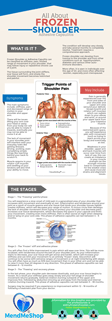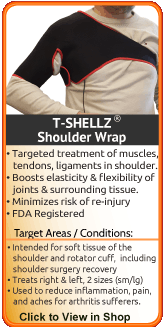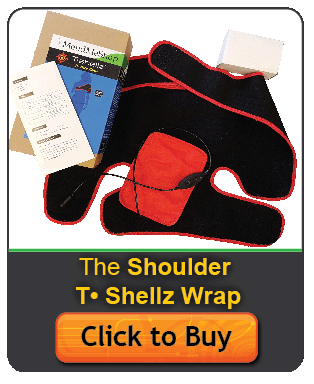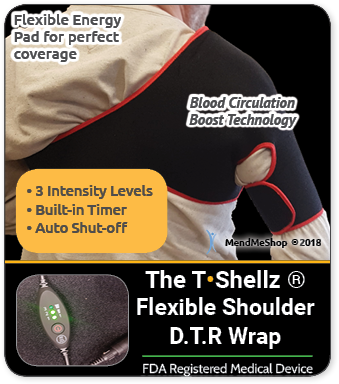Ice vs Heat for Treating Frozen Shoulder
When dealing with frozen shoulder pain (adhesive capsulitis) it's hard to know what treatment will work best for you. You might be wondering if ice and heat will work for you. Or maybe even which will work better - ice OR heat.
Icing and heating are 2 of the most natural treatment options available. Compared to medications, surgery and other treatment methods - icing and heating have been around for centuries and have always been used for frozen shoulder and shoulder injury healing as a means to soothe and heal.
We understand that it can get pretty confusing to figure out what conservative treatment method will work best with all of the treatment options available to you today. To get started, you should think about the benefits you'll get from using these treatments.
What's Better to Treat Your Frozen Shoulder Pain:
Ice or Heat?
Ice and heat are the best treatment combination for you if:
- You're looking to boost the natural power of pain relief and healing in your body.
- You don't want to repeatedly pay the cost (both from your wallet and time needed for long-term healing) of injections, medications, hospital visits or surgery.
- You want to reduce the risk of re-injury, pain or swelling in your shoulder.
- You want to reduce the risk of worsening the injury.
- You want to control your own treatment and recovery at home, on your own time.
- You're looking for a tried and tested method of healing that has worked for countless other frozen shoulder pain sufferers.
Combining cold and warmth is a simple yet effective way to get immediate pain relief and promote long-term healing. In your lifetime you've probably had your mom, family doctor, nurse, surgeon or physical therapist tell you to use ice right after you're injured and something warm from time to time once the swelling's gone down. It's a simple yet very effective way to relieve pain and promote healing in your shoulder.
Frozen shoulder disease can happen to anyone - right now there are thousands of doctors and physical therapists dealing with patients that require a solution to their soft tissue injury fast and heal it (where possible). If you want to be proactive about properly dealing with your shoulder pain, speak to your doctor about adding conservative temperature treatments to your recovery with AidMyFrozenShoulder's system using a Cold Compress or Ice Pack and Circulation Boost with a Shoulder TShellz Wrap®.
Note: If you have an Acute (recent, inflamed) Soft Tissue Injury, Do Not Use Heat.
Your doctor knows that the sooner cold is applied, the quicker you can reduce inflammation and achieve real pain relief. This will help reduce the chance of a much longer lasting chronic injury. Heat and inflammation are a bad mix and should not be used together. Heat is good at the spa - it will help your body relax, but when it comes to an injury it is not a good idea (unless your physician specifically recommends otherwise).
Which is Better for Treating Frozen Shoulder:
Ice or Heat?
People get confused with how ice and heat work to relieve pain and heal. They also get confused with which temperature treatment is better for their injury and how to get the right amount of "ice" or "heat" for effective treatment.
When it comes to using ice and heat for treating a frozen shoulder injury, it's important to keep in mind that both ice AND heat are very effective ways to relieve pain and heal. Most people will think one is better over the other from their own experience or what a doctor / physical therapist has previously told them.
The only difference between using ice and heat is that 1 is better for you at a specific time in your healing cycle and whether your frozen shoulder injury is at the 'freezing', 'frozen' or 'thawing' stage. Ice is used first, right when you get your injury (during the 'freezing' stage), to decrease pain / swelling and inflammation. Ice is also essential when your frozen shoulder starts to heal in the 'thawing stage', as your pain spikes while you regain movement of your shoulder.
Heat comes later, to increase blood flow circulation and stimulate the body's healing response. Heat is also the best treatment when you're experiencing extreme limitation of movement in your shoulder - during the 'frozen' stage of your injury. Heat relaxes the scar tissue surrounding your shoulder joint capsule, making it more pliable and flexible while speeding up the natural healing response that will eventuall 'thaw' out your injury.
So which is better?
They'll ultimately work for you in the same way. Each temperature has its own unique benefits for frozen shoulder healing, and when used togther they provide a powerful advantage to long-term healing. You may already know that ice or heat feels better on your shoulder, and this could influence your decision too.
The bottom line is that ice and heat are exceptional, natural, pain relievers and healers for your frozen shoulder injury.
There are times when frozen shoulder injuries will respond better to 1 temperature over the other. We want to help clear up the confusion so you know which is better (icy cold or gentle heat) and how to get the most from your treatment at home.
How Do You Use Ice / Cold for Frozen Shoulder Pain Relief?
COLD (ice) is used to treat injuries or conditions that are red, hot, inflamed, swollen and suffering from tissue damage (a tear or recovering from surgery). Cold is a natural / organic pain reliever that numbs pain right at the source of your injury. While doing this, the cold also stops tissue break-down and reduces the amount of scar tissue forming (this is very important after surgery).
When cold is applied to a frozen shoulder injury, all of the soft tissue in the shoulder joint will squeeze on the veins to slow down your blood flow. This in turn clamps down on the amount of fluid leaking into your injured tissue, decreasing your swelling. This is why cold is used immediately to treat newer shoulder injuries or re-injuries. The cold slows down your body to stop the amount of damage happening to your tissue and decrease your swelling. This cold also has a nice side benefit of numbing the nerves in and around your shoulder thereby decreasing your pain.
In the medical world this is something called 'Vasoconstriction'.
Cold can Make Your Frozen Shoulder Injury Worse - How?
Applying cold can restrict blood flow and stiffen / tighten soft tissue. Cold is NOT a good treatment method for your frozen shoulder when the tissue is already tight and constricted, because the cold will just stiffen the tissue further.
A good example of this would be when you're in the 'frozen' stage of your frozen shoulder injury. During this stage your overall shoulder and arm movement is restricted to the point where you can't even raise your arm at all. Your entire shoulder feels stiff and it's painful and difficult to move. Using cold at this time will stiffen up the soft tissue in your shoulder even more making it impossible for your tissue to flex at all. If you've had frozen shoulder for a while then you're all too familiar with how stiff your shoulder can get and how impossible it can be to move it.
At these times, when your shoulder is tight with restricted range of motion, you should use a therapy that will increase blood flow, like a Shoulder TShellz Wrap® to relax and elongate soft tissue in the treatment area, making it much more pliable.
When To Use Cold to Treat Your Frozen Shoulder
Cold works best to relieve pain, swelling and inflammation for new injuries, re-injury and during immediate post surgery recovery. Cold should also be used during the first 24 - 72 hours of treatment, combined with resting your injury.
If you've been suffering for some time with a chronic frozen shoulder injury you should only use cold after activity causes you more pain or as you regain range of motion in your shoulder (during the 'thawing' stage) and feel some pain.. This would be when your shoulder starts to hurt at the end of the day after you've been using your arm for normal, daily tasks the entire day. When used at this time cold becomes a natural / organic pain reliever, treating the site where you feel the pain.
Sometimes we feel pain while doing a certain activity - should you still use cold? Too much cold can reduce your ability to heal correctly, because cold is a short term pain reliever not a deep tissue healer.
Here are a couple of frozen shoulder treatment examples:
You have a frozen shoulder injury that's been on-going for quite some time.
You're having a "good day" (your injury is feeling fine) and decide to head out for some grocery shopping. You realize afterwards that was a bad idea because your shoulder is throbbing and even more painful than the day before.
You should use COLD on your shoulder to stop further damage to your joint capsule and help ease the pain.
You have an on-going, painful frozen shoulder injury.
You're in the kitchen making a cup of tea and reach in your cupboard to get a mug. You forgot about your injury but realize it's there when you can't raise your arm high enough to grab the mug... Reaching for that mug just reminded you that your arm can only move so far with a sharp pain / twinge when your arm gets 'stuck' halfway to the cupboard. You stop and ask someone else to retrieve the mug for you (you stopped the activity that will cause more tearing in your shoulder).
The pain was temporary and is now gone. If no swelling is expected to result from this, NO cold compression is needed.
In this case heat (Circulation Boost) should be used to encourage healing of your frozen shoulder and help your tissue to relax / become more flexible/elastic in nature (so your arm won't stick as much next time).
It's crucial to use cold after any sort of activity causes you on-going pain.
Use a Cold Compress or Ice Pack:
- 24 to 72 hours after your initial shoulder injury or when you first notice pain and swelling to stop tissue damage, relieve pain, and decrease swelling.
- After exercise, workouts or activity of any kind to prevent re-injury.
- Before and after surgery during rehabilitation to control pre and post-surgery pain and swelling.
- Anytime you feel your shoulder tissue is tender, painful or you're having a flare-up of an old frozen shoulder injury.
- Anytime you have swelling, sharp throbbing pain or inflammation in your shoulder.
- Any other situation where you need to draw the pain and inflammation out of your shoulder.
How Do You Use Heat / Warm Temperatures to Heal & Recover from Frozen Shoulder?
HEAT (warmth) is used after you've reduced your swelling / inflammation and the sharp pain is less intense (you have more of a dull / nagging ache and soft tissue tightness in your shoulder). Warming up your tissue is a natural way to encourage more blood flow (and due to this, increase the body's healing response) to soft tissue. It's the blood in your body that will bring oxygen, nutrients and water (basically energy) to your injured shoulder to help with healing and speed up the natural 'freezing' and 'frozen' stages of this injury.
Heat can Make Inflammation, Swelling and Newer Injuries Worse - How?
When we injure ourselves, we start healing right away. The body will naturally raise the temperature at the site of the injury resulting in the inflammatory response (redness, heat sensation, inflammation and swelling). This hotness encourages blood flow to the area to cool it down and start the healing process.
Adding 'heat' to your shoulder when it's already inflamed and tender may make your body think there's a new threat to your tissue and increase the pain in order to get you to stop. For some people, applying heat on inflamed / swollen tissue will cause the injury to swell-up even more (as much as 3 times larger than normal). You'll feel even more pain as the pressure builds in your entire shoulder joint.
Heat is NOT a good treatment method for inflamed frozen shoulder injuries (during the 'freezing' stage), new injuries (within the first 24 to 72 hours), right after surgery or right after a re-injury (over-use and/or sharp, throbbing pain). In these cases, heat should be applied later on in the healing cycle. In the meantime, use a Cold Compress or Ice Pack to decrease any inflammation induced pain.
When Should You Use Heat to Heal Your Frozen Shoulder?
Heat / warming temperature treatment works best to increase blood flow circulation and reduce risk of a cyclic injury process. Warmer temperatures should be used approximately 3 to 5 days after you first have the injury once initial swelling has calmed down. For post-surgical recovery, heat should not be started for a least 2 weeks after surgery because inflammation levels will be very high as the healing process starts over again. Any use of heat should also be combined with gradual movement to stretch out your shoulder with the intent of increasing range of motion (or at least preventing further atrophy and soft tissue shortening due to lack of use).
Heat is critical for dealing with the 'frozen' and 'thawing' stages of your frozen shoulder injury. You should be using heat when your shoulder has limited range of motion. Espeically if your arm keeps getting 'stuck' when you try to raise your arm up and use your shoulder. Heat used at this time will relax the tissue making it more flexible. Use of heat will also speed up the natural healing process of your frozen shoulder injury.
Each stage of a frozen shoulder injury can take months or even years. You may suffer for 4 months to a year just with limited movement and stiffness in your shoulder. It usually takes another 5 months to 3 years for your frozen shoulder injury to recover naturally. Healing will be much more efficient, and tissue will remain more flexible with regular use of heat.
If you have a chronic frozen shoulder injury that keeps getting re-injured you should use heat before activity to loosen up your tissue (making it more flexible). When used at this time the warm temperatures naturally extend the elasticity (elastic-nature) the tissue surrounding your shoulder joint capsule, making it more movable / pliable for activity.
Sometimes we feel pain while doing a certain activity - should you still use heat? Using heat in the morning before you start your day or before activity can help to boost the healing process and reduce your risk of re-injury. Too much heat (especially when you suffer a set-back with swelling / inflammation) can make your inflammation worse. Cold should be used part-way through your day when you suffer from on-going pain and inflammation as a natural pain-reliever.
Using heat is a good long-term plan because it will help to stimulate healing and can also be used on a preventive basis to relax constricted soft tissue. We use warm temperatures / heat to speed up the process of baking something in the oven or melting the snow outside, your injury is no different. Heat will speed up the natural healing rate in your shoulder by increasing your blood flow circulation. This in turn brings all the components your tissue needs to heal - oxygen and nutrients (basically energy).
Here Are A Couple More Heat Vs Cold Treatment Examples:
You suffered from a frozen shoulder injury 2 years ago, but since then the injury has healed a little and you no longer feel pain everyday.
You've regained some of your range of motion and can move your shoulder a lot better than you could 6 months ago. You started taking a new Zumba dance/exercise class and notice your shoulder feels even more stiff the day after you exercise. There's no pain, inflammation or swelling in your shoulder, just stiffness / soreness around your shoulder.
You should use HEAT (Circulation Boost) on your shoulder before your exercise classes to loosen up your shoulder. Heat can be used again the next day if you notice any residual stiffness. If the stiffness remains, you should continue to use heat to make sure your old frozen shoulder injury doesn't get worse.
You're starting to notice a very slow onset of mild pain in your shoulder that increases with movement.
Eventually, when laying in bed at night, you notice the soreness in your shoulder continues. Now every night is restless with little to no sleep because of intense pain and tenderness in your shoulder. The pain keeps getting worse which means NO heat is needed.
In this case a Cold Compress or Ice Pack should be used as a natural pain-reliever. The cold will also decrease the amount of damage being done to your shoulder.
Keep using the TShellz Wrap® Shoulder Wrap before activity OR when you notice stiffness in your shoulder to 'warm up' your tissue and stimulate greater blood circulation to the area.
With regular use of the Shoulder TShellz Wrap:
- Your pain will be reduced.
- In most cases, your body's healing process will be accelerated (due to enhanced blood circulation) with reduced potential for re-injury*.
- Soft tissue in the treatment area will have a enhanced range of motion and increased extensibility of collagen tissue. (Chapter 9 of "Therapeutic Heat and Cold", 4th edition.
(amazon.com link - Ed. Justus F. Lehmann, M.D., Williams, and Wilkin)
Our high quality wraps are registered with the FDA as medical devices which meet high manufacturing standards.
When To Use a Shoulder TShellz Wrap (HEAT):
- After swelling and inflammation have been reduced with cold compression.
- Before exercise or workouts to warm up your shoulder & prevent re-injury.
- Before and after surgery during rehabilitation to warm up your tissues before PT exercising or stretching.
- Anytime you feel your shoulder has stiffened up, is tight and your shoulder gets stuck when you try to raise your arm up.
- Anytime you have sore or aching tissue.
- Any other situation where you need to increase blood flow to your injury to relax your shoulder, relieve trigger point pain / spasms, prevent re-injury and enhance flexibility of your tissue.
How to Use Ice and Heat to Relieve Your Frozen Shoulder Pain
The main symptoms of frozen shoulder (adhesive capsulitis) are stiffness, pain and decreased range of motion. Usually you wind up not being able to lift your arm up over your head or away from your body. Being unable to move your shoulder in these ways will majorly interefere with everyday tasks like getting dress, driving, working or reaching for anything.
With an injury like frozen shoulder, muscle spasms in your rotator cuff and scar tissue build-up around your shoulder joint capsule are major problems. These things cause pain and stiffness making it so you don't WANT to move your shoulder. Then when you keep your arm still, the pain and stiffness gets worse. Eventually you won't be able to move your arm at all.
There are 3 stages that you go through with a frozen shoulder injury - 'freezing', 'frozen' and 'thawing'. Each stage causes new symptoms in your shoulder and requires a different combination of ice and heat to relieve the pain, decrease the stiffness, speed up your natural healing and increase your range of motion.
There's a Unique Formula used for Recovery from a Frozen Shoulder Injury...
We're going to let you in on the secret to healing frozen shoulder injuries... The vicious cycle of 'freezing', 'frozen', and 'thawing' will repeat itself over and over again if you don't use conservative treatment to add to your healing at home and make sure your shoulder heals right the first time.
We have a Professional 3-Step Treatment Formula that will break this cycle for you:
Step 1 - Use Cold in the 'Freezing' Stage
During this 'freezing', painful, stage your shoulder joint gradually becomes very stiff as a result of muscle spasms and scar tissue that binds the soft tissue in your shoulder tigether and tigether. Over time you'll notice a decrease in your range of motion. Your pain may be worse at night when you're sleeping or at any time when you sleep on your side.
The 'freezing' stage can last 1 to 9 months.
Application of cold during the initial period of this 'freezing' stage will naturally relieve your pain and numb tissue to decrease pain and swelling. It will also reduce the amount of damage that happens to your rotator cuff and shoulder joint capsule tissue, which decreases the amount of scar tissue that builds up in your joint. Start with a 20 minute cold treatment whenever you notice the pain from your shoulder joint tissue 'freezing' in place. You might find it helpful to also use cold after activity, in the middle of the night if you're in too much pain to sleep, or any other time where your shoulder is throbbing in sharp pain.
Step 2 - Use Heat in the 'Frozen' Stage
The pain you initially felt during the 1st stage will gradually start to drop off as your shoulder joint becomes 'frozen' in place. The inflammation will decrease as the scar tissue around your shoulder joint capsule gets harder. This fast build up of scar tissue will increase stiffness in your shoulder and will limit your movement entirely. You may notice the stiffness and discomfort of your frozen shoulder injury gets worse with any type of normal daily task or activity you try to perform. Your shoulder will feel like it's 'sticking' in place.
The 'frozen' stage can last 4 months to 1 months.
This is the ideal time for a heat treatment via the Shoulder TShellz Wrap treatments to bring more blood flow into your shoulder joint. This blood flow will help to soften the scar tissue (making it a lot less hard and rigid) while increasing the flexibility of all of the soft tissue in your shoulder.
A TShellz Wrap® treatment helps increase elasticity of soft tissue, stimulate blood flow & reduce risk of reinjury due to overstrain.
Use a Shoulder TShellz Wrap for 10 to 20 minutes before starting your day or performing any activity. A Shoulder TShellz Wrap will promote a Localized Enhanced Circulation Response - an increase in blood flow to your shoulder while warming up and relaxing your constricted tissue.
Continued treatment with Circulatory Boost will also deliver much-needed oxygen, nutrients and water (basically energy) to your shoulder. This will maximize your body's ability with regard to self recovery.
Step 3 - Continue Using Your Shoulder TShellz Wrap in the 'Thawing' Stage
This is the last stage of your frozen shoulder injury. As you get through this stage you'll notice your shoulder pain will decrease drastically as the scar tissue in your joint begins to loosen up. Your stiffness will start to go away and you'll be able to regain the range of motion in your shoulder over time.
Much like the 'freezing' stage (where the scar tissue is building up) this stage of your injury can be very painful as the scar tissue begins to break down. Using a Shoulder TShellz Wrap during this stage is crucial for your overall recovery. When there is inflammation or a lot of pain, use a Cold Compress or Ice Pack .
You'll need to continue using cold to reduce your pain and prevent any further injury to your shoulder. However, the Shoulder TShellz Wrap® is also essential to make sure that your shoulder does not undergo reinjury as this can extend your recovery for a very long time. Use the Shoulder TShellz Wrap treatments before activity, and a Cold Compress or Ice Pack after to speed up your recovery process and reduce re-injury risk to your shoulder.
The 'thawing' and recovery stage can last 5 months to 3 years.
Our Frozen Shoulder Formula Works
It may seem hard to believe, but our Shoulder TShellz Wraps® will assist you in your recovery process by reducing your swelling and inflammation induced pain and maximizing blood flow where it's needed most.
Here at AidMyFrozenShoulder we pride ourselves in helping you with your healing and recovery process. Everyone at AidMyFrozenShoulder has tested and used the products, finding solutions to conditions that do not fit into the norm. This dedication to our customers and our products goes hand-in-hand with our guarantees to you as a customer:
- Guarantee #1 - Use your products diligently for up to 60 days and you will experience a significant reduction in pain. If not, I encourage you to send back the items for a 100% refund.
- Guarantee #2 - You will not be left in the dark after purchasing any product from us. AidMyFrozenShoulder Advisers and Product Specialists are available 5 days a week by toll free phone 1-866-237-9608 or email to answer your questions or concerns.
- Guarantee #3 - Your order is guaranteed to be shipped within 24 hours on every business day.
- Guarantee #4 - All purchases receive a one year, full replacement warranty with guaranteed, prompt service.
- Guarantee #5 - You could save hundreds of dollars and possibly more, by utilizing our products, and getting back to work sooner.
Product Advisors are available 9:00 am to 5:00 pm Eastern Standard Time Monday to Friday.
Living with pain is never easy and we encourage you to call us with any questions you have related to your knee injury. We will do our best to help.
Learn More About Shoulder Injuries & TreatmentsI want to learn more about Frozen Shoulder Causes. I want to learn more about TShellz Wrap® Circulatory Boost I want to learn more about Ice & Heat: Which Is Better For Treatment? I want to learn more about Trigger Points. I want to learn more about Frozen Shoulder Manipulation. I want to learn more about Post Surgery Recovery?
FREE SHIPPING ON ALL PRODUCTS CURRENTLY ENABLED
60 DAY TRIAL PERIOD
During your recovery, you will probably have to modify and/or eliminate any activities that cause pain or discomfort at the location of your soft tissue injury until the pain and inflammation settle. The more diligent you are with your treatment and rehabilitation, the faster you will see successful results!
| 











